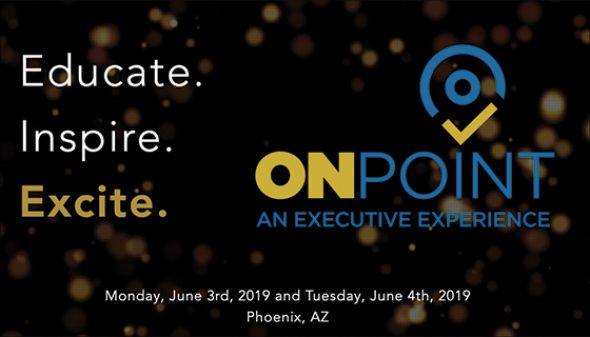
The best days are ahead of us…. This was a key tenet of John O'Leary's keynote presentation at this year's IASA Annual Conference and Business Show in Phoenix, Arizona. It was just one of many sessions featured in the OnPOINT executive education program. OnPOINT was an exclusive event for C-suite executives, held within the broader IASA conference, and designed around the themes of educate, inspire, and motivate. The session was inspiring and left me asking myself the question that John posed to all of us in the audience: What more can I do to make tomorrow even better than today?
As I pondered that question, I reflected back on the OnPOINT sessions I attended for the past day-and-a-half and started to think about it from an industry perspective. What more can we do as an industry to make tomorrow even better than today? How can we make things better for the industry we serve? There were presentations throughout the program and discussions about ideas and topics that I believe are forward-thinking and speak to this question.
In a session titled, “Workplace of the Future: How Robots Will Elevate, Not Replace Your Team and the Impact of Innovative Thinking,” Robotic process automation (RPA) and machine learning were two topics discussed that lend themselves toward making tomorrow even better than today for insurers. RPA is software in the cloud that is great for high-volume, low-variability processes. An example would be taking a claim payment and posting the claim information directly into your payment ledger. This could allow insurers to focus their staff on higher-level tasks, where their expertise becomes more important. The amount of unstructured data – emails, social media, paper documents, phone recordings – is increasing exponentially. Machine learning can help by performing the “first-pass” through these documents to look for actionable insights. Teaching machines to scour through this unstructured data and look for things you are interested in can save valuable time for you and your employees, while increasing the accuracy of the searches, as machines do not become tired or bored of searching.
Another portion of the agenda was spent on what the IASA calls, "Conversations of Four." Four attendees sit at tables to discuss topics of interest for 20 minutes. Then they are instructed to get up and find another table with a different topic that they are interested in, and talk about that topic with three other attendees for 20 minutes, and so on. The conversations were free-flowing and allowed attendees to ask questions, share ideas, talk about past experiences, and discuss best practices on a range of topics. There is no doubt that these conversations led to new ideas that attendees could take back to their offices to implement to make tomorrow even better than today in their workplace.
Insurtech continues to be a hot topic, and Guidewire's Laura Drabik presented an OnPOINT session on the topic. She was joined by two insurtech companies, Betterview and FRISS. The session was titled, "Critical Industry Evolution: How Insurtech is Making the Insurance Industry Bold.” Laura talked about how our industry is growing and stretching through insurtech. Insurtech is the confluence of insurance and technology and where the industry meets its boldness, she said. Betterview and FRISS were showcased as two examples of how insurtech is making the industry bold. Betterview provides insurers with a predictive analytics platform that uses machine learning to structure various types of property and building data, making it actionable for their customers. They can help the customer experience by mitigating potential risk. For example, Betterview can identify a tree branch hanging over a roof and suggest trimming it back to prevent a future claim. FRISS helps insurers fight fraud on new applications and claims. For example, insurers can scan a new application to provide a FRISS score for that piece of business, which is an indication of the risk that may be associated with the application. In the end, this can help prevent a high-risk business from entering an insurer’s book of business.
These examples illustrate opportunities for us to make things better for tomorrow, both for the industry we serve and for the individual companies we work for. We are moving in the right direction and the best days are ahead of us.

